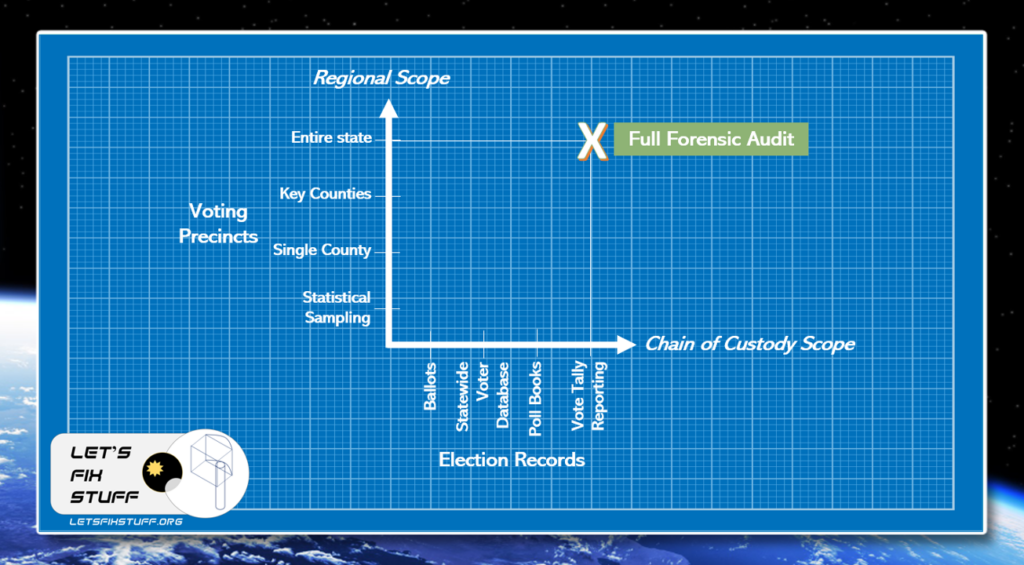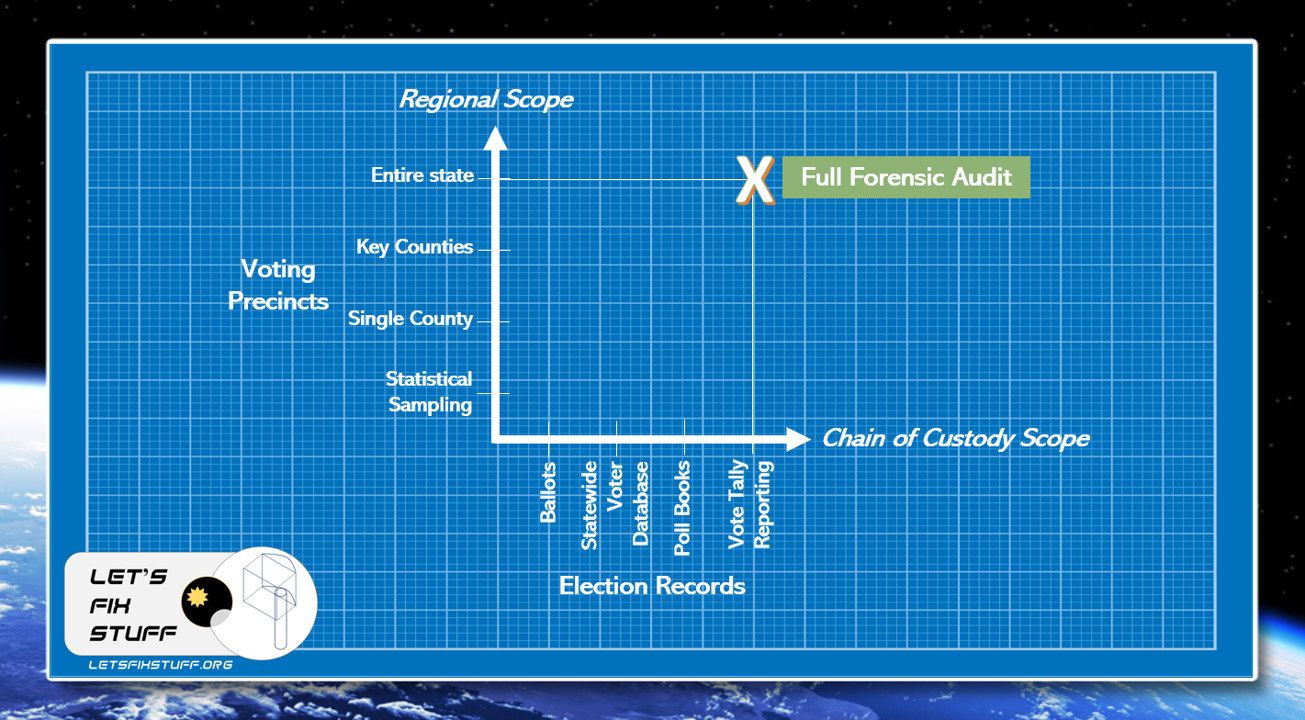By Patrick Colbeck
The term “full forensic audit” is growing in use all across America. I addressed the term “forensic audit” in a previous post, but the addition of the term “full” by some people attempting to differentiate their audit proposals from the those proposed by others demands closer examination. To underscore this need, a large group of elected officials at the 10-12 August 2021 Cyber Symposium in Sioux Falls, SD sponsored by Mike Lindell formed the Election Integrity Caucus with the expressed mission of conducting a forensic audit of the 2020 election in all 50 states. In order to support this endeavor, I believe it is important to examine exactly what is meant when people refer to the need for a “full forensic audit”.
Scope
The term “full” implies that it correlates some measure of the scope of an audit. When one goes about the work of proposing a forensic audit, this scope discussion can have significant bearing on the cost of the audit. There are two primary measures of scope in this context – 1) Regional Scope and 2) Chain of Custody Scope. Of course, the ultimate goal would be an audit of the full regional and chain of custody scope. In the final analysis, though, funding and timing will determine what audit scope can reasonably be executed.

Regional Scope
Regional scope measures the percentage of voting precincts to be examined forensically during the audit. The more precincts covered, the more complete the audit. If 100% of the precincts are audited in a state, the audit could claim that it was an audit of the entire state, but it would not necessarily be a “full” forensic audit. In order to claim that a “full” forensic audit has been proposed, it would need to address 100% of the election records in the chain of custody for a given election. In other words, even if 100% of the ballots cast in a given election were audited, one could not genuinely claim it was a “full” forensic audit unless the ballot audit was supplemented by an audit of the remaining election records.
Chain of Custody Scope
Chain of Custody scope measures how many of the election record classes in the election Chain of Custody will be examined forensically during the audit. The more classes of election records covered, the more complete the audit. If 100% of the election record classes are audited in a given voting jurisdiction, one could claim that a full forensic audit of that jurisdiction has been completed.
Statement of Work
What would a basic statement of work look like for a “full forensic audit”?
I would break down the work for a full forensic audit as follows:
- Work Package 1 (WP-1): Ballot Assessment
- Work Package 2 (WP-2): Qualified Voter File Assessment
- Work Package 3 (WP-3): Poll Book Assessment
- Work Package 4 (WP-4): Election Night Reporting (ENR) Assessment
- Work Package 5 (WP-5): Prime Contractor
Let’s look at what activities are involved in each of these work packages.
WP-1 Ballot Assessment
- Conduct high speed scan of all ballots cast
- Evaluate ballot scans using software tool
- Determine vote count based upon ballot scans
- Examine scanned ballots for fraud
- Report on fraud indicators determined via software
- Physically examine a subset of ballots for fraud indicators that require physical examination
WP-2 Qualified Voter File Assessment
- Gather electronic data (QVF snapshots, change logs, account information)
- Evaluate electronic data
WP-3 Poll Book Assessment
- Gather electronic and physical data
- Evaluate electronic and physical data
- Conduct canvassing to verify data (Leverage volunteers)
WP-4 ENR Assessment
- Gather electronic data (time stamp logs
- Gather physical data (data transfer logs)
- Evaluate Data
WP-5 Prime Contractor
- Coordinate activities for all work packages
- Public relations
- Compile an integrated report delineating findings and recommended corrective actions for all work packages
Regional Scope
Specify one of the following options for your regional scope:
- Option 1) Entire State
- Option 2) Key Counties
- Option 3) Single County
- Option 4) Key Municipalities
- Option 5) Single Municipality
- Option 6) Key Precincts
- Option 7) Single Precinct
Chain of Custody Scope
Specify the chain of custody scope by selecting one or more of the following work packages:
- WP-1: Ballot Assessment
- WP-2: Qualified Voter File Assessment
- WP-3: Poll Book Assessment
- WP-4: Election Night Reporting (ENR) Assessment
- WP-5: Prime Contractor
Costs
Rule of Thumb Cost Estimates
Since forensic audits of election records are a relatively new exercise, there is not a lot of data available to provide cost estimates. Having said that, preliminary cost data is available for the audit of Maricopa County, AZ audit that would indicate that the audit of 2.1M ballots cost $5-7M. This works out to roughly $3/ballot. Some have proposed ways to leverage technology to reduce this cost in future audits to as little as $0.25/ballot. Ultimately, any organization seeking to perform a forensic audit should ask vendors for quotes for each work package consistent with the regional scope for that work package.
Funding Sources
Another important consideration regarding costs is the source of funding. There are three basic categories of funding sources.
- Government
- Non-Government Organizations
- Private Entities
Government
Government entities (e.g. state, county, municipalities) can appropriate taxpayer dollars to fund an audit. This approach often goes hand-in-hand with significant political considerations that may delay or even corrupt the conduct of the audit. Furthermore, the assignment of contracts to auditors would need to proceed through government procurement processes that may or may not result in the most qualified vendor from being awarded the contract.
Non-Government Organizations
Non-Government Organizations (NGOs) include 501c3 or 501c4 organizations in which the allocation of funds in support of an audit would align with their mission statement. These organizations would then allocate grants to organizations formed by the leaders of the audit sufficient to conduct the audit. These grants would likely stipulate requirements regarding the conduct of the audit with which the audit team must comply.
Private Entities
Private entities include businesses or individuals interested in supporting an audit. Crowdfunding tools such as GiveSendGo.com can be used by audit organizers to solicit and realize donations in support of an audit from businesses or individuals.
Conclusion
The term “full forensic audit” should be used with care. One could rationally assert that an audit of all of the ballots in a given state is a partial audit because it ignores the other records in the election record chain of custody. One could also rationally assert that an audit of the complete election record chain of custody in only one county is a partial audit because it ignores the other counties. The ideal situation would be to request a “full forensic audit” whenever practical. We need to recognize, however, that it may be impractical to conduct a “full forensic audit” for a given jurisdiction due to pragmatic fiscal or timeline constraints. In this light, we need to guard against the flippant use of the term “full forensic audit” with the intent of demeaning otherwise substantive audit activities. Audits require sufficient resources in order to be executed. Having said that, however, it is reasonable to ask elected officials responsible for allocating those resources whether or not they believe that the integrity of our election system should be a higher priority than other allocations of taxpayer funds.
Related Posts
Election Process Audit Map: Good Stuff and Bad Stuff



I assume the purpose of a forensic audit of an election is to prosecute those responsable for fraud in an election. I think the Michigan legislature would need a “Special Prosecutor” to follow up on evidence generated. Is this in law or the Michigan Constitution? If we ever get off the ground in Michigan with a forensic audit, who would you recommend as Special Prosecutor?